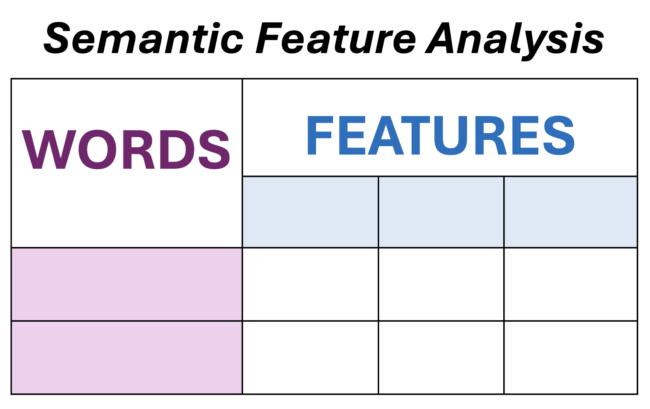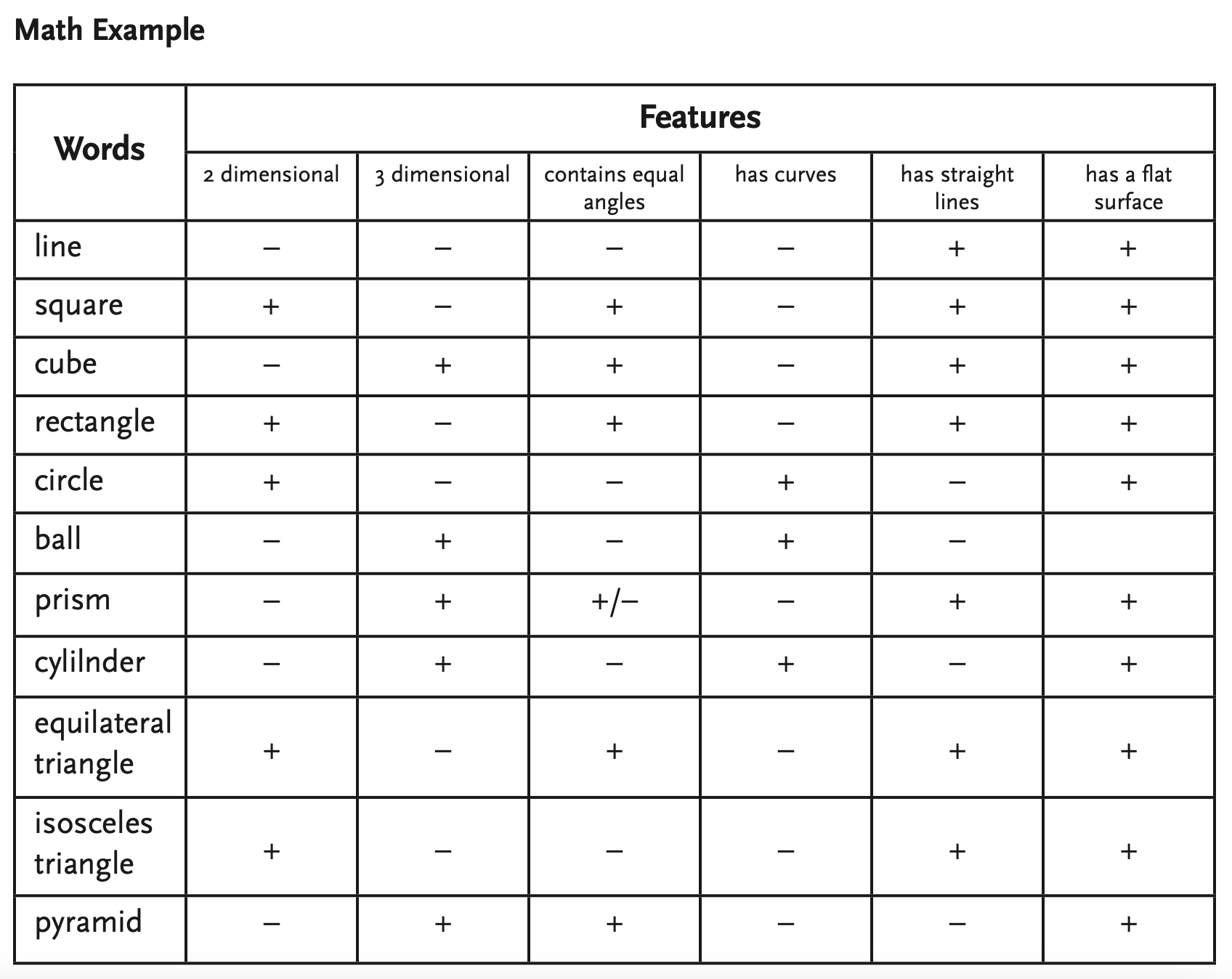Building Vocabulary: Semantic Feature Analysis

It is helpful for students to learn a new word by associating it with other related words. The related words can be words students already know or new words. Semantic feature analysis is an engaging activity that can be used to make associations.
One critical finding from research is that word learning takes place most efficiently when the reader or listener already knows something about the context related to a new word. We learn words up to four times faster in a familiar context than in an unfamiliar one (Landauer & Dumais, 1997; Hirsch, 2006). Vocabulary instruction that compares and contrasts word meanings and activates prior knowledge not only helps students learn new words, but has been shown to improve comprehension of the reading selection that includes the words being taught (Graves, 2006).
Schema, Four Activities to Connect Words
A schema is a mental map that represents and organizes one’s understanding of a particular topic. Vocabulary is used to represent that knowledge. Word learning is most efficient when a connection to existing schema can be made. It is like giving students a “hook” on which to hang a new word.
When a new word is taught in relation to other words, information becomes available that is unique to how that word is being used in context. Many words have multiple meanings and different connotations depending on the subject area. They can also be different parts of speech. When associations can be made to other words, students will acquire a better understanding of how a new word is being used in a specific text or related classroom discussion.
The Brain Dictionary video presents an interactive map that scientists have developed showing which areas of the brain respond to hearing different words. The map reveals how language is spread throughout the cortex and across both hemispheres, showing groups of words clustered together by meaning. This model highlights the connections among words and related background knowledge in the dictionaries in our heads. What is your reaction to the video?
The Key Vocabulary Routine professional development course presents instructional suggestions for four activities that can be used for helping students make connections among words: Semantic Mapping, Categorizing, Scaling, and Semantic Feature Analysis, the focus of this post. All four activities:
- help students make connections between new and known words
- help students make connections between background knowledge and concepts, and words associated with the concepts
- provide opportunities for rich discussion about words
- push students to go beyond simply learning definitions to actively thinking about the connections between word meanings and how words are similar and different
What is Semantic Feature Analysis?

Semantic Feature Analysis (SFA) is a well-researched activity that helps students recognize similarities and differences among related words (Baldwin et al., 1981; Johnson & Pearson, 1984). A relational matrix, or grid, is used to show how related words are alike and different.
To generate a SFA matrix, the teacher selects a list of related vocabulary words and places them along the left column of the grid. Some knowledge of the words is necessary in order to begin, so it is best to do this activity after words have been previewed or after students have read a passage containing the words. The teacher supplies features across the top of the grid that highlight how these words might be similar and different. To complete the grid, students consider each word and determine if each feature applies to the word. A plus sign (+) is placed in the corresponding block on the grid if the feature is associated with the word, and a minus sign (-) is placed if it is not. If students are not sure, a question mark (?) can be placed in the block. This activity is more effective if students work collaboratively with peers to complete the activity.
Sometimes, depending on the context, both a plus or minus sign can be given. There is often no absolutely correct answer. Through discussion and disagreement about whether a feature is applicable or not, students gain a deeper understanding of the ways a word can be used. An extension of the activity is to have students generate additional related terms for the vocabulary list, or to generate additional features. View the examples below from mathematics, social studies, and science classrooms.



You Try It!
Can you think of a set of words related to a text your students are reading or subject area content you are teaching that lend themselves to a Semantic Feature Analysis activity? Download this SFA template to create your own SFA activity by adding words to the left column and generating features across the top.
References:
- Baldwin, R.S., Ford, J.C. & Readance, J.E. (1981). Teaching word connotations: An alternative strategy. Reading World, 21, 103-108.
- Graves, M.F. (2006). The vocabulary book. New York: Teachers College Press.
- Hirsch, E.D. (2006). Building knowledge: The case for bringing content into the languagearts block and for a knowledge-rich curriculum core for all children. American Educator 30(1). American Federation of Teachers.
- Johnson, D.D., & Pearson, P.D. (1984). Teaching reading vocabulary, (2nd ed.). New York: Holt, Rinehart, and Winston.
- Landauer, T.K., & Dumais, S.T. (1997). A solution to Plato’s problem: The latent semantic analysis theory of acquisition, induction, and representation of knowledge. Psychological Review, 104 (2), 211-240.

 Joan Sedita is the founder of Keys to Literacy and author of the Keys to Literacy professional development programs. She is an experienced educator, nationally recognized speaker and teacher trainer. She has worked for over 35 years in the literacy education field and has presented to thousands of teachers and related professionals at schools, colleges, clinics, and professional conferences.
Joan Sedita is the founder of Keys to Literacy and author of the Keys to Literacy professional development programs. She is an experienced educator, nationally recognized speaker and teacher trainer. She has worked for over 35 years in the literacy education field and has presented to thousands of teachers and related professionals at schools, colleges, clinics, and professional conferences.
Leave a Reply